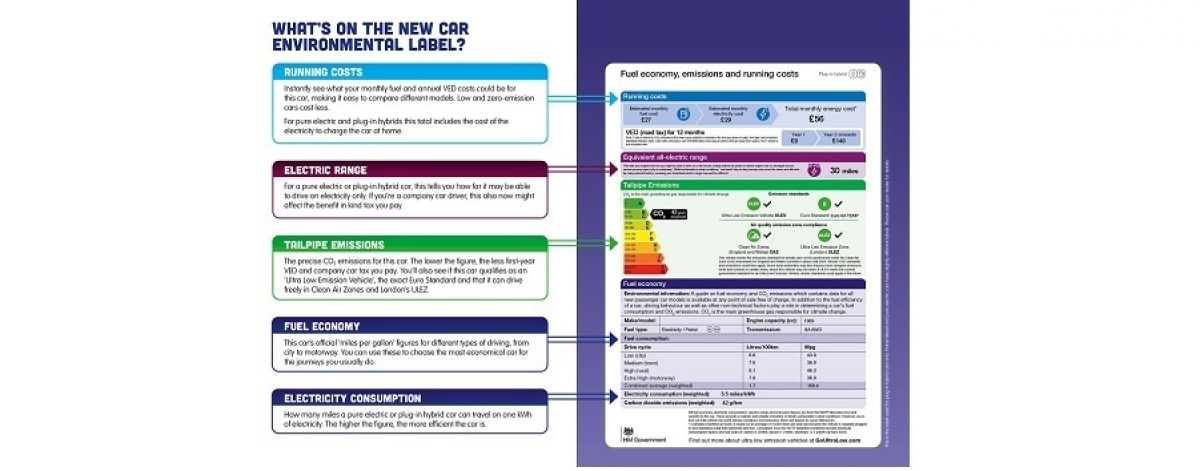
Survey shows environmental friendliness and running costs are now more important for consumers.
A survey commissioned by the Low Carbon Vehicle Partnership (LowCVP) and the National Franchised Dealers Association (NFDA) has found that motorists considering a new car are now more concerned about ‘going green’ – with 50% saying that environmental friendliness has become more important to them in the last year. In the same survey, despite today’s record low fuel prices, almost as many (43%) potential buyers said that running costs are also now more important than they were*.
To help drivers easily identify the most efficient environmentally friendly cars available, a new car environmental label is now in use at all new car dealerships. This enables showroom visitors to instantly see which new cars have the lowest emissions, running costs and longest electric range, making it easier to compare and find the new car most suitable for them.
The New Car Environmental Label – making the right choice easy
The new car environmental label has been redesigned by the Low Carbon Vehicle Partnership (working with the Department for Transport and Vehicle Certification Agency) to include additional valuable information that’s clearer, easier to follow and actively encourages motorists to consider low or zero-emissions cars.
Compare monthly running costs
A new ‘running costs’ section allows motorists to instantly see how their monthly costs can vary between vehicles, emphasising the big savings possible from electric and the most fuel-efficient cars. And because costs are a key motivator, this is one of the best ways to persuade buyers to adopt the very cleanest vehicles.
Which has the lowest emissions?
There’s more detail on a car’s tailpipe emissions, including being able to drive in Clean Air Zones (which all new cars can) and if the car qualifies as a ‘ULEV’ (Ultra Low Emission Vehicle). The level of CO2 emissions is very clearly shown too, making it obvious which cars produce the least greenhouse gas.
The best electric range
For plug-in hybrids and pure electric cars, the electric range has been detailed, helping motorist understand just how capable today’s electric cars are – and their suitability for almost every journey.
All the information on these labels uses the latest more reliable and robust WLTP figures, which should be specific to the car on display.
The new car environmental label is found next to every new car on display in car showrooms or at events. There are three versions – one for petrol and diesel cars, one for plug-in hybrids and a third for pure electric.
“It’s very understandable that motorists now have a desire for more efficient, environmentally friendly new cars that cost less to run with very low or zero emissions” commented Jason Doran, Head of Marketing at the Low Carbon Vehicle Partnership; “They may however be surprised just what a difference this can make: a typical petrol car might cost around £95 per month in fuel, whereas a pure electric car only £26. That’s a saving of over £800 a year, all with zero tailpipe emissions**. All this information and more is now very clearly shown on the redesigned new car environmental label.”
Sue Robinson, Director of the NFDA, said, “With the increasing importance of running costs and environmental friendliness, it is crucial that motorists are enabled to choose the latest, low and zero emission cars that are best suited to their needs and lifestyle. Franchised retailers play a key role in informing their customers and the new car environmental label will represent a very useful tool”.
Keeping Consumers Informed
LowCVP have produced a simple consumer guide to make showroom visitors (and staff) aware of the redesigned car label and how the new information helps motorists choose the lowest carbon car for their journey. This will be freely distributed electronically to all NFDA dealers, to make available for visitors. This guide is also freely available for media use.
Download the New Car Label - consumer guide
Download the New Car Label Infographic
Download the Plug-in Hybrid New Car Label April 2020 - example
* The survey was carried out between 3 and 5 June by independent research company DRG; respondents were UK adults aged 17 to 75 adults planning to buy a new car.
The question “Thinking about the next time you will buy a new car (i.e. not used), has the importance of environmental friendliness changed for you in the last year?” had 660 respondents planning to buy a new car. 50% of them indicated environmental friendliness has become more important for them, while 44% said this has not changed, and 6% said it has become less important.
The question “Thinking about the next time you will buy a new car (i.e. not used), has the importance of running costs changed for you in the last year?” had 676 respondents planning to buy a new car. 43% of them indicated running costs have become more important for them, while 51% said this has not changed, and 6% said it has become less important.
** Typical estimated fuel costs shown assume combined fuel and electricity consumption figures of 47.9mpg for a petrol and 4miles/kWh for an electric car, based on driving 10,000 miles per year with fuel costs of: petrol £1.20/litre; electricity 12.5 p/kWh (at April 2020). The precise figures for each car on display are shown on the new car label.
Although dealerships remained closed, the ability of many motorcycle dealers to offer an online sales facility for new and used machines has proved its worth with many customers using the ‘click & collect’ option to acquire their new form of two-wheeled commuter transport in May.
Offering the opportunity to avoid traffic congestion and save on parking charges, motorcycles will continue to represent a valid alternative to public transport going forward. The motorcycle industry has been promoting the safe use of power two wheelers as a viable option to commute and current rider licence holders, as well as new riders, have responded positively by acquiring lower-powered motorcycles and scooters.
There is dealer optimism that the worst is over and as some of the UK’s four countries come out of lockdown, demand for both new and used commuter size motorcycles and scooters is bound to increase”.
